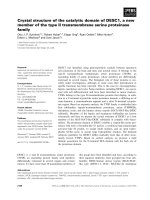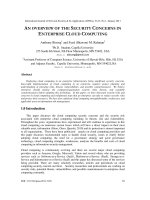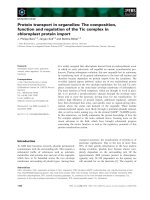Sarcoidosis of the Upper Lung Fields Simulating Pulmonary Tuberculosis pptx
Bạn đang xem bản rút gọn của tài liệu. Xem và tải ngay bản đầy đủ của tài liệu tại đây (768.25 KB, 6 trang )
Sarcoidosis of the Upper Lung Fields
Simulating Pulmonary Tuberculosis
Alvin
S.
Teirstein,
M.D.,
F.C.C.P." and
Louis
E.
Siltzbach,
M.D.,
F.C.C.P.""
Fifty-four of
616
patients
(9
percent) with sarcoidosis exhibited upper lung field
radiographic abnormalities, which mimicked adult tuberculosis. Difficulty in
diagnosis occurred when patients presented with residual upper zonal shadows,
which had persisted after clearing of lower and
midzooal densities. The abnormal-
ities of sarcoidosis appeared as streaks and nodules simulating
acinonodose tu-
berculosis. Contraction of the upper zones with retraction
of
the mediastinal
structures may be just
as
prominent
as
in fibrotic tuberculosis. Bube can
some-
times be mistaken for tuberculous cavities, and small multiple radiolucencies
may be mistaken for tuberculous bronchiectasii Awareness that upper zonal
sarcoidosis
rewesents a residual manifestation of the more
usual
att tern
of hilar
adenopathy
a;ld diffuse lower and midzonal infiltrations,
aids
in dkkngnishing this
radiographic pattern from that
of
adult tuberculosis. Obtaining a radiograph
dating back
tian earlier stage can be crucial in making this differentiation. when
confronted with upper lung field abnormalities, the diagnosis of sarcoidosis as
well
as
tuberculosis should come to mind and appropriate clinical support should
be sought.
he radiographic patterns of pulmonary sarcoido-
Tsis when localized to the upper lung zones may
closely mimic the typical appearance of pulmonary
tuberculosis, often leading to confusion in diagnosis.
Symmetrical bilateral hilar and right paratracheal
lymphadenopathy is recognized as the hallmark of
early intrathoracic sarcoidosis
(
stage
1
).I
Later, in
approximately one half of the patients, pulmonary
mottling appears and may assume either a
micro-
nodular, reticular or confluent patchy configuration
(stage
2).
These radiographic shadows may be
diffusely distributed or they may be localized. Final-
ly, in the third stage, the enlarged mediastinal lymph
nodes regress and only the pulmonary components
of intrathoracic involvement may
remain2 When in
the third stage, residual parenchymal infiltrations
are predominantly localized to the upper lung zones,
'Associate Clinical Professor of Medicine, The Mount Sinai
School of Medicine, New York.
"Clinical Professor of Medicine, The Mount Sinai School of
Medicine, New York.
The work was supported by USPHS, National Heart and
Lung Institute Grant No.
HL
13853, and The Sadie and
Louis
Elow Foundation.
Manuscript received December 21, 1972; revision accepted
March 28. 1973.
Reprint requests:
Dr.
Teirstein,
70
East
90th
Street, New
York
City
10028
CHEST,
VOL.
64,
NO.
3, SEPTEMBER, 1973
they may easily be confused radiographically with
the lesions of pulmonary tuberculosis, especially
when earlier radiographs have not as yet become
available. Among
616
patients with a tissue-con-
firmed diagnosis of sarcoidosis observed at the
Mount Sinai Hospital, New York, we found
54
pa-
tients
(9
percent
)
whose radiographs disclosed
such pulmonary densities in the upper zones without
the accompanying tell-tale hilar adenopathy.
All
54
subjects had histologic findings compatible with
sarcoidosis on organ biopsy or a positive Kveim test reaction
or both. Tuberculin skin testing was
carried through the
second-strength purified protein derivative (PPD) (250 TU
[tuberculin units]
)
or to 1.0 mg of old tuberculin
(
OT)
(
100
TU). Cultures of sputa and gastric contents for acid-fast
bacilli were perfonned
as
required and all proved to be
sterile. Other studies included determinations of serum pro-
tein, calcium, phosphorus, and alkaline phosphatase levels as
well
as
slit lamp examination of the eyes. Radiologic views of
the bones of the hands and feet were performed, mainly in
patients with chronic cutaneous sarcoidosis.
Obseruations
There were three fairly distinct
radiogra'phic patterns of
upper zone localization of sarcoidosis, each of which
simn-
Downloaded From: on 01/07/2013
TEIRSTEIN, SILTZBACH
FIGURE la. Chest radiograph of 31-year-old white woman
demonstrating bilateral upper zonal linear densities simulating
shadows of pulmonary tuberculosis.
lated those of pulmonary tuberculosis: (1) unilateral or
bilateral micronodular, patchy or linear densities occupying
the apical and subapical region of the upper lobes (30
patients); (2) opacification with shrinkage of the upper
lobes, often with considerable upward retraction of the lung
roots and deviation of the trachea to the more affected side
(five patients
);
and
(
3)
small or large radiolucent areas in
the upper zones, with thin walls, but occasionally with fairly
thick margins
(19
patients). Most of these patients also
showed upward retraction of the lung roots.
Micronodular and Linear Densities
(30
Patients)
The micronodular densities of sarcoidosis may assume a
unilateral or bilateral upper zonal pattern reminiscent of
acinonodose tuberculosis.
Figure la
is
the chest radiograph of a 31-year-old white
woman which shows bilateral upper lobe streaks.
Six
years
preuiously, the chest radiograph of the same patient shown in
Figure lb displayed disseminated nodules throughout both
lungs accompanied by enlarged mediastinal lymph nodes. It
was then readily recognized as pulmonary sarcoidosis (stage
2). At that time, the pulmonary nodulation was even more
prominent in the midzones than in the upper zones, and
continued to grow in prominence over the next year. Tuber-
culin skin tests remained negative throughout her course.
Cultures of gastric contents were negative, a liver biopsy
revealed noncaseating epithelioid granulomas and the Kveim
test reaction was positive. As Figure la shows, the midlung
lesions cleared over the next five years, but the residual
upper zone densities persisted and, in the absence of prior
radiographs, one could readily have considered these den-
sities to be tuberculous foci.
In this instance, the upper zonal densities of sarcoidosis
represented residual shadows of diffusely disseminated lung
granulomas initially involving
all
of the lung zones. While
lower zonal shadows underwent resolution, the lesions in the
upper zones persisted. Localized upper zonal densities in
pulmonary sarcoidosis evolve most commonly in this fashion.
Another example of micronodular and linear densities in
the upper zones
is
illustrated by the radiograph of a patient
with sarcoidosis, whom we could obse~e with multiple chest
radiographs over a two-year period. In this instance, the pul-
FIGURE lb. Chest radiograph of same patient six years earlier,
showing widened mediastinum and diffuse bilateral nodular
and linear densities throughout all lung zones, consistent with
radiographic stage 2 sarcoidosis.
FIGURE
20.
Chest radiograph of 24year-old Negro woman
with bilateral upper zonal nodular and linear densities, with
confluence of shadows in right upper zone suggesting tuber-
culosis.
CHEST,
VOL.
64,
NO.
3,
SEPTEMBER,
1973
Downloaded From: on 01/07/2013
SARCOlDOSlS SIMULATING PULMONARY TUBERCULOSIS
FIGURE
2b.
Chest radiograph of same patient
21
months
earlier demonstrating pattern of radiographic stage
1
sarcoi-
dosis.
monary mottling was confined solely to the upper zones,
while the lower and midzonal areas remained clear through-
out the course.
Figure
2a
is the chest x-ray film of a 24-year-old Negro
woman which reveals streaky and nodular densities in the
subapical portions of both upper lobes, more extensive on the
right than on the left. On the basis of this film alone, the
likeliest diagnosis would be pulmonary tuberculosis. Twenty-
one months earlier (Fig
2b),
the chest x-ray film of the same
patient had revealed the classic pattern of sarcoidosis,
ie,
bilateral hilar and right paratracheal lymph node enlarge-
ment with
clear
lung fields. Tuberculin skin tests were
negative, gastric aspirates failed to grow tubercle bacilli, and
the Kveim test reaction was microscopically positive.
Opacification with Shrinkage of the Upper Zones (Fiue
Patients)
In the second pattern of upper zonal sarcoidosis, the chest
radiograph may assume, after several years' duration, an
appearance of densely fibrotic pulmonary tuberculosis, with
areas of opacification and retraction upwards of the hilar
structures, with deviation of the trachea to the more affected
side. Figure
3a
is the chest radiograph of a 49-year-old
Puerto Rican-born woman which reveals such shrinkage and
opacificati?n of the right upper lobe, with deviation of the
mediastinum and retraction upwards of the right lung root.
This radiologic appearance might be regarded as typical of
chronic fibroid tuberculosis. However, a chest film made six
years
earlier
(Fig
3b)
exhibited normally placed mediastinal
structures with mid- and lower zonal pulmonary nodulation, a
distribution of x-ray shadows more characteristic of sarcoido-
sis. The tuberculin skin tests were persistently negative,
repeated gastric aspirates failed to grow acid-fast bacilli and
the Kveim test reaction was positive.
Small and Large Radiolucencies in the Upper Zones
(19
Patients)
The scarring of late pulmonary sarcoidosis is accompanied
FIGURE
3a.
Chest radiograph of 49-year-old Puerto Rican-born
woman showing shrunken right upper lung zone with devia-
tion of trachea and upward retraction of lung root, which
prompted radiologic diagnosis of tuberculosis.
by the formation of bullae of varying size. Sometimes these
bullae may attain giant proportions. Since these lucencies are
most often located in the upper zones, they mimic tubercu-
lous cavities and associated bronchiectasis.s.4
Confusion between the bullous transformation in the upper
zones seen in end-stage pulmonary sarcoidosis
(
Fig
4)
and
giant tuberculous cavities led to the
unnecessary
codnement
of a 34-year-old Negro woman
in
a tuberculosis sanatorium
for five years. Although the tuberculin skin test was positive
to
10
TU,
repeated cultures of sputa and gastric contents for
I
d
FZGURE
3b.
Chest radiograph of same patient six
years
earlier
showing normally
placed
trachea and lung root with bilateral
mid- and lower zone nodulations and hilar node enlargement
consistent with sarcoidosis.
CHEST, VOL.
64,
NO. 3, SEPTEMBER, 1973
Downloaded From: on 01/07/2013
TEIRSTEIN, SILTZBACH
FIGURE
4.
Chest radiograph of 34-year-old Negro woman
demonstrating bilateral apical lucencies, broad densities in
both midzones and basilar nodules, &st thought to be
cavi-
tary
pulmonary tuberculosis.
Skin
biopsy, positive Kveim
test reaction and later postmortem examination established
diagnosis of sarcoidosis.
tubercle
bacilli
failed to reveal any organisms. Biopsy of a
facial skin lesion demonstrated noncaseating epithelioid cell
granulomas without acid-fast bacilli and a positive Kveim test
reaction finally established the diagnosis of sarcoidosis.
Since patients with extensive pulmonary fibrosis and large
bullae usually suffer from markedly impaired pulmonary
function, it was not surprising that this patient succumbed to
cardiopulmonary failure.
At
autopsy, the diagnosis of dissem-
inated sarcoidosis was con6rnyd and no evidence of tuber-
culosis was found.
Sometimes the lucencies
in
the upper zones in pulmonary
sarcoidosis are small and assume a honeycombed pattern
which
also
may be confused with posttuberculosis bronchiec
task when previous chest x-ray films are not readily available.
FIGURE
5u.
Chest radiograph of 38-year-old Negro woman
showing bilateral upper lobe honeycombing, which mimicked
tuberculous bronchiectasis.
FIGURE
5b.
Chest radiograph of same patient three and one-
half years earlier revealing linear densities and lucencies
throughout all lung zones conforming to stage
3
sarcoidosis.
The chest roentgenograph of a 38-year-old Negro woman
(Fig
5u)
demonstrates such multiple small lucencies within
areas of fibrosis in the upper lobes. However, a series of
roentgenographs beginning three and one half years
earlier
(Fig
5b)
was later obtained and on the first
film
showed
infiltrations in all lung zones. In the interval, clearing of
infiltrates occurred from below upward, a pattern consistent
with the behavior of lesions in sarcoidosis. The patient had
negative tuberculin skin tests and sterile gastric cultures for
tubercle bacilli. The Kveim test reaction was positive. Hy-
percalcemia and hypercalciuria were also present. With mr-
ticosteroids and no added antituberculosis drug therapy, the
clinical and radiologic manifestations of sarcoidosis improved.
In
the 6nal example, another diagnostic problem was
FIGURE
6.
Chest radiograph of 27-year-old Negro woman,
with known sarcoidosis. Bilateral upper zonal linear densities
and positive tuberculin test gave rise to question of super-
imposed tuberculosis. Negative cultures for tubercle bacilli,
clearing of densities concomitant with sarcoid skin lesions
while receiving adrenocorticosteroid and no antituberculous
therapy, and lung biopsy con6rmed only sarcoidosis.
CHEST, VOL.
64,
NO.
3,
SEPTEMBER,
1973
Downloaded From: on 01/07/2013
TEIRSTEIN, SILTZBACH
10 James DG, Pepys
J:
Tuberculin in aqueous and oily
solutions: Skin test reactions in
normal subjects and
in
patients with sarcoidosis. Lancet 1:602-804, 1956
11 Chusid
EL,
Shah
R,
Siltzbach LE: Tuberculin sensitivity
in sarcoidosis: Fifth International Conference on
Sar-
coidosis,
(
Levinsky L, Macholda
F,
eds
)
:
Karlova, Praha
Univ Press, 1971, pp 139-143
12
Lofgren S: Erythema nodosum: Studies on etiology and
pathogenesis in 185 adult cases.
Acta Med Scand
(
Suppl.
)
174: 1-197, 1964
13 James DG: Erythema
nodosum: Br Med
J
1:853-857,
1961
14 Teirstein AS, Siltzbach LE: Sarcoidosis with accurately
dated onset:
A
study of 100 patients with initial erythema
nodosum: Sixth International Conference on Sarcoidosis,
Tokyo, 1972, in press
Australia's Aborigines
Scientists are certain that the Aborigines were origi-
nally immigrants who came from southeast Asia through
Indonesia to Australia's northern coasts possibly
20,000
years ago. One can find Aborigines in the south who are
extremely hairy-men with chest and body hair nine
inches long, women with very apparent facial
hair-
while others in the Great Victorian Desert have copper-
colored skin, prominent brow ridges and sloping fore-
heads. Some Aborigines in the north are taller, heavier
and bigger-boned than the thin and wiry people who
inhabit the borders of the Northern Territory and West-
ern Australia. Except for their dark-brown eyes and
chocolate color, they are almost European
in
appear-
ance. In western
Arnhem Land,
in
the north, you can
find people less than five feet tall, some small boned and
delicately shaped, others thickset and squat. In the Alice
Springs area, there are children who are blond. Cultural-
ly the Australian Aborigines have traditions which bind
them together. But here again the diversity of styles and
attitudes, implements and art forms defies generaliza-
tion. There was no common language to unite the
Ah-
origines before the European arrived. It has been esti-
mated that anyone who wished to speak to all Aborigines
in
Australia (before English began to serve as a
lingua
franca) would have needed to acquire fluency in about
150
separate languages, comprising more than
600
dialects.
Cotlow,
L:
The Twilight of the Primitive,
New York,
hlacmillan,
1971
CHEST, VOL.
64,
NO.
3,
SEPTEMBER,
1973
Downloaded From: on 01/07/2013
TEIRSTEIN, SILTZBACH
10 James DG, Pepys
J:
Tuberculin in aqueous and oily
solutions: Skin test reactions in
normal subjects and
in
patients with sarcoidosis. Lancet 1:602-804, 1956
11 Chusid
EL,
Shah
R,
Siltzbach LE: Tuberculin sensitivity
in sarcoidosis: Fifth International Conference on
Sar-
coidosis,
(
Levinsky L, Macholda
F,
eds
)
:
Karlova, Praha
Univ Press, 1971, pp 139-143
12
Lofgren S: Erythema nodosum: Studies on etiology and
pathogenesis in 185 adult cases.
Acta Med Scand
(
Suppl.
)
174: 1-197, 1964
13 James DG: Erythema
nodosum: Br Med
J
1:853-857,
1961
14 Teirstein AS, Siltzbach LE: Sarcoidosis with accurately
dated onset:
A
study of 100 patients with initial erythema
nodosum: Sixth International Conference on Sarcoidosis,
Tokyo, 1972, in press
Australia's Aborigines
Scientists are certain that the Aborigines were origi-
nally immigrants who came from southeast Asia through
Indonesia to Australia's northern coasts possibly
20,000
years ago. One can find Aborigines in the south who are
extremely hairy-men with chest and body hair nine
inches long, women with very apparent facial
hair-
while others in the Great Victorian Desert have copper-
colored skin, prominent brow ridges and sloping fore-
heads. Some Aborigines in the north are taller, heavier
and bigger-boned than the thin and wiry people who
inhabit the borders of the Northern Territory and West-
ern Australia. Except for their dark-brown eyes and
chocolate color, they are almost European
in
appear-
ance. In western
Arnhem Land,
in
the north, you can
find people less than five feet tall, some small boned and
delicately shaped, others thickset and squat. In the Alice
Springs area, there are children who are blond. Cultural-
ly the Australian Aborigines have traditions which bind
them together. But here again the diversity of styles and
attitudes, implements and art forms defies generaliza-
tion. There was no common language to unite the
Ah-
origines before the European arrived. It has been esti-
mated that anyone who wished to speak to all Aborigines
in
Australia (before English began to serve as a
lingua
franca) would have needed to acquire fluency in about
150
separate languages, comprising more than
600
dialects.
Cotlow,
L:
The Twilight of the Primitive,
New York,
hlacmillan,
1971
CHEST, VOL.
64,
NO.
3,
SEPTEMBER,
1973
Downloaded From: on 01/07/2013









